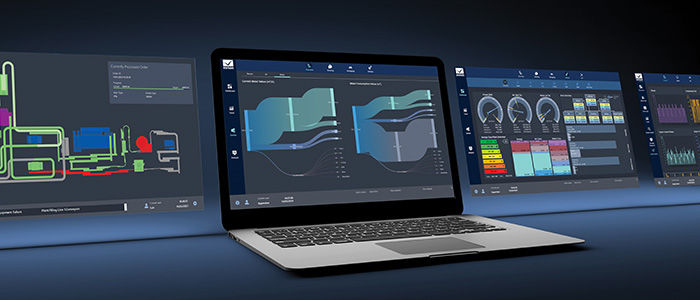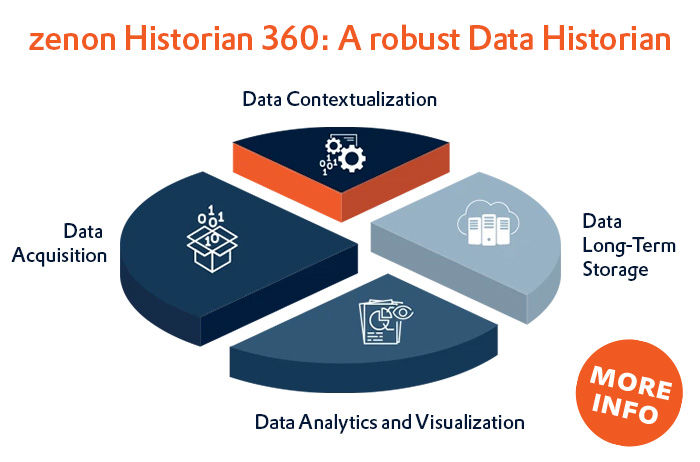What to consider when choosing a Data historian
The modern manufacturing industry is a dynamic environment where information technology (IT) and operational technology (OT) intersect. Today's Internet of Things (IoT) sensors have made it possible to gather and analyze more data than ever before, yet parsing and using raw, unstructured data can be challenging for traditional database programs built to manage relationships. As a result, demand has grown for tools capable of meeting the specific process data collection, archival and analysis needs conventional databases can't fulfill.
Enter the full-featured Process historian, a real-time solution to a successful combination of IT and OT.
What is a Data historian?
A Data historian is a tool for recording process data collected from industrial automation, such as information from a facility's IoT sensors. The resulting data allows businesses to monitor their performance more efficiently, reduce anomalies for better quality and identify opportunities to create a competitive advantage with real-time visibility into their operations.
Process historians appeared in the late 1980s with industrial automation tools like supervisory control and data acquisition (SCADA) systems. As a companion to SCADA, they first found homes in industries like chemical production, oil and gas, pharmaceuticals and utilities. Though they're practical additions to companies where uptime and reliability are crucial, they've since become valuable in many other industries and have expanded to include additional functionalities.
Historians generally handle two distinct types of data — time-series and event-based data.
Time-series data comes from process data from equipment sensors pulled at specific intervals. This information can range from analog data, like a machine's speed or coolant level, to aggregate data, like moving averages and digital readings.
Historians capture event-based data in response to predefined circumstances. You configure the criteria triggering the historian to record and forward data like alarms and audit trails.

Typical Data historian features and applications
Since the Process historian's primary objective is to gather and store time-series information across the industrial ecosystem, these tools have some common features to make them ideal for many applications. Manufacturing professionals and engineers across numerous industries turn to them to plan, forecast, schedule and manage equipment and processes more effectively.
Data collection
Today's manufacturing environment has thousands of touch points for data, from processes to equipment with varying numbers of sensors.
A full-featured Process historian allows you to measure and gather data for any relevant industrial metric sensors can track. For example, zenon helps you centralize industrial process data like quality assurance metrics as well as analog figures like temperature and flow rate.
Data storage and archival
Time-series data rapidly accumulates thanks to its systematic collection. Process historians take various approaches to eliminate redundancies and compress files for archiving, using complex algorithms to reduce storage needs.
zenon Historian 360 uses its binary data format for archiving and supports data export to limit the storage footprint. These archives remain immutable and can transfer to local storage for easy retrieval.
Data forwarding
While data storage and archival are essential, they're not the only features a powerful Process historian platform needs — forwarding functionality is equally crucial. The underlying objective of forwarding capability is to ensure complete data. When an on-premise historian loses a connection with a remote database, it can lead to data gaps and inaccurate analysis. A full-featured solution will include an automatic switch to local data storage, with the historian later forwarding the captured data once the connection is reestablished.
Historian interfaces
The modern industrial data ecosystem is complex, comprising numerous infrastructure components, sensors and equipment working harmoniously to support operations. Sometimes, the Process historian resides off-site and uses separate interfaces to ensure smooth communication between endpoints and the platform. These specialized interfaces deploy on-site to create reliable connections with nearby sensors, capturing or archiving relevant data and transmitting it to the primary historian platform.
Alarm and event management
Many full-featured Process historians serve as alarm management tools to enhance operational efficiency and safety. By configuring custom event-based triggers, the historian can send notifications and alerts when it detects process errors, machine malfunctions or quality issues. Powerful computing capabilities allow the historian to monitor numerous events simultaneously, and modern solutions can also gather data on any relevant operator interventions to generate reports for analysis.
Data validation
A complete historian solution includes functionality for data validation by confirming it with your metadata. Depending upon the application, this metadata — often called tags — includes information like the measurement unit, polling frequency and data source. Not all of your metadata is relevant to the specific research you may want to perform, but it's valuable for sorting and verifying to ensure you're extrapolating the correct data for your analysis.
Data analysis and visualization
The ideal historian solution allows you to do more than collect and organize data — it also includes tools to help you model and visualize it more meaningfully. These tools range from simple graphs and charts to complex overlays with detailed views and comparisons. Fortunately, modern historians include intuitive features allowing you to group time-series data based on logical relationships, add calculations and combine event-based filters to customize your analysis and visualization.
Data historians versus databases: Is there a difference?
Since it captures data, is a Process historian a database? The simple answer is yes, yet there are numerous differences when comparing a Process historian versus a relational database.
First, Process historians differ from standard databases in the questions they answer. For example, relational databases are ideal for delivering information on customer order volumes. The historian is the solution for understanding data like the standard deviation between two production runs.
Next, Process historians work in real time and must quickly gather information in harsh, fast-paced industrial environments. As a result, well-designed historians offer faster read/write speeds than standard databases. Their creators also build them to withstand the demands of manufacturing floors.
Another key difference of historians is their ability to compress the data they capture to use storage space more efficiently. Conversely, relational databases often grow as companies add more fields and data relationships. That expansion naturally requires more storage space and is often also more time-consuming to maintain, unlike a Process historian.
Finally, Process historians have a clear edge in implementation versus standard databases. Using common communication protocols, a plant can deploy a historian quickly and without the need for custom coding relational databases often require. The faster implementation also means a more rapid return on investment.
How to know if you need a Data historian
Determining whether you need a Process historian can seem challenging at first glance. It's advisable to consider what goals you want to achieve with the data you collect and analyze from your IoT-connected equipment. These solutions are ideal for gathering and gaining valuable insights for applications like:
- Tracking production and machinery downtime for more effective planning and scheduling.
- Diagnosing, maintaining, monitoring and troubleshooting industrial equipment to prevent unplanned downtime.
- Creating automatic regulatory documentation across the production cycle to reduce manual recordkeeping.
- Receiving real-time event alerts for faster interventions.
- Streamlining workflows for efficiency and resource maximization.
- Monitoring defects within specific time frames to help pinpoint root causes.
What to consider when choosing a Data historian software platform
There's no single correct approach for every business when it comes to how to choose a Process historian software. Still, there are numerous vital factors to consider when narrowing the field. The weight to give each one will differ based on your unique organizational needs and workforce.
Ease of deployment and use
Process historian platforms vary widely in their internal architecture, integration capacities and user-friendliness, so choosing an easy-to-deploy and simple-to-use solution should be a primary consideration. If a platform is overly complex to implement and maintain, it puts excess demand on your IT team. Information collection and analysis become more challenging, and data gaps persist. Similarly, unfriendly user experiences can result in prolonged adoption cycles and increased end-user resistance. Solve both of these challenges with zenon Historian 360. You get a platform requiring minimal deployment and maintenance effort, while your end users get numerous dashboard customization options and an easy-to-navigate interface.
Integration capability
Your Process historian solution needs to work with your existing resources to be successful at meaningful data extraction, so you must consider a platform's integration capabilities before committing. Features like web application programming interfaces (APIs) and built-in drivers help support holistic data collection from your disparate systems.
With zenon, you have robust connectivity with over 300 native drivers, process gateways and IIoT Services for third party integrations. Capture the data you need from your SCADA system, enterprise resource planning software and other connected sources in one centralized platform for a faster path toward data-driven decision-making.

Data quality
Your data collection sensors represent a crucial way to extract and record valuable information from your manufacturing processes and equipment. If these sensors are not correctly aligned with metadata such as measurement units, equipment and sources, challenging variances can occur that may limit the accuracy and usefulness of the data you gather.
A full-featured Process historian platform like zenon helps resolve these issues. You can quickly and easily export data for local storage in multiple formats, validate it against metadata, then archive it and extract it for analysis. For example, an SQL export creates clear-text files retaining their integrity for use with zenon Service Engine.
On-premise versus cloud deployment
Deciding whether an on-premise or cloud deployment is the best option for your business is another crucial consideration since both have advantages and drawbacks. For example, choosing an on-premise implementation involves hosting your Process historian solution on your local servers. Doing so can create higher data security and reliability confidence through dedicated connections.
A cloud-based solution like zenon offers accessibility from any connected device, making it exceptionally convenient. Plus, web-based platforms provide more affordability and fast scalability. Working with a proven partner like COPA-DATA also supplies you with powerful integrations, reliable uptime and expertise dedicated to continuous platform improvement.
Support, documentation and user community
You'll rely on your Process historian to extract, organize and analyze large data volumes from your many connected sources, with each information layer increasing the complexity. That means you need a solution offering robust technological support, in-depth educational resources and an active user community for shared knowledge.
When you choose zenon Historian 360, you can access resources like the self service portal in order to help answer your questions. You can also explore a range of tutorial videos, get certified with exclusive training programs in the zenon Academy and draw on others' expertise through our active user community. Plus extra support when you need it or assist via Professional Services.
Costs
Finally, you want to consider how well a potential solution meets your budgetary needs since cost-effective procurement is a key driver for business growth. Some Process historian platforms may impose costs that aren't apparent at first glance. For example, a solution with a licensing model charging based on required data capacity can quickly accrue excess charges. Likewise, you need to account for initial deployment costs and the expenses associated with long-term platform maintenance and support. Typically, those costs are higher for on-premise historians than for cloud-based solutions. COPA-DATA provides transparent upfront pricing to help you make more informed purchasing decisions and maximize your technology investments.
The Data historian market
The current Process historian market is broad, developed from the need to gather, organize, store and analyze data from industrial automation solutions. As automation gained traction in modern industrial settings, data became more challenging to extract and research with the existing tools. The market experienced a boom as IoT technology became more available, and there was a need to integrate data collection from these innovations.
Many experts today expect the market to continue growing steadily in the coming years, as Process historians are a wise investment for numerous industries and applications. Various factors will spur this anticipated growth, including:
- An increasing emphasis on industrial performance improvements: Every business has its key performance indicators, and tracking the meaningful metrics contributing to their progress is essential to identifying opportunities for improvement. Historians enable data collection from every process aspect to deliver increased visibility, creating efficiencies in highly competitive industries.
- Expanding IoT infrastructure and applications: Much of today's industrial process data is unstructured information that may not fit within the confines of traditional relational databases. As users deploy more IoT sensors and explore new ways to use them, there'll be a corresponding increase in data. Process historians help solve this issue through scalability and interoperability — they can grow and bring together siloed data for a more cohesive picture.
- More use of Big Data in numerous economic sectors: Companies are increasingly gaining more valuable insights through their data analysis, and more industries realize their data's power to deliver a competitive edge and drive growth. Process historians use real-time statistics to support better agility and resilience in dynamic environments across all economic sectors.

What is the zenon Historian 360?
zenon is a powerful, full-featured solution for data recording with a history dating back to 1987 and a global footprint as an innovative platform for merging IT with OT — a leading force in supporting industrial automation and digital transformation.
zenon continues to evolve to meet the requirements of many demanding industries:
- Energy and infrastructure
- Food and beverage
- Automotive
- Life sciences and pharmaceutical
- Process industry
- Machine building
As a Process historian solution, zenon Historian 360 offers the functionality to:
- Detect anomalies sooner by recording essential process information from any connected industrial touch point, with over 300 built-in native drivers supporting standard communication protocols.
- Establish a single source of truth by connecting with existing infrastructure and centralizing data from third-party systems.
- Archive data with a proprietary binary format.
- Support an unlimited number of archives and archive variables that can work in parallel.
- Identify quality issues precisely and create documentation automatically with time stamps in millisecond increments.
- Visualize complex data holistically and at granular levels by modeling data with zenon Report Engine.
Expand your data insights with COPA-DATA
Our zenon Historian 360 allows you to gather, organize, analyze and centralize process information from disparate sources for a unified, real-time view across your enterprise. As a cloud-native solution, zenon Historian 360 provides unparalleled connectivity at cost-effective prices.
Discover more about zenon Historian 360's capabilities to transform your business's industrial process data collection and analysis by connecting with a COPA-DATA team member online.














































